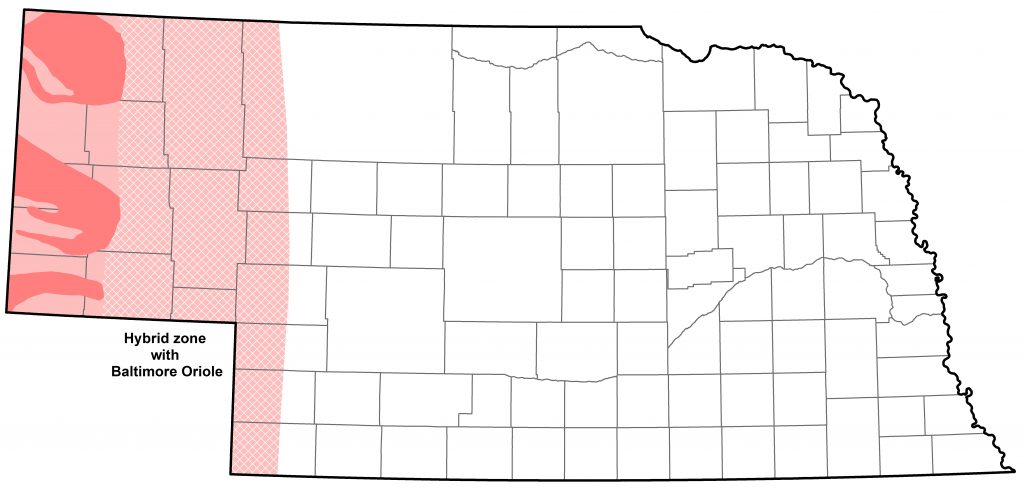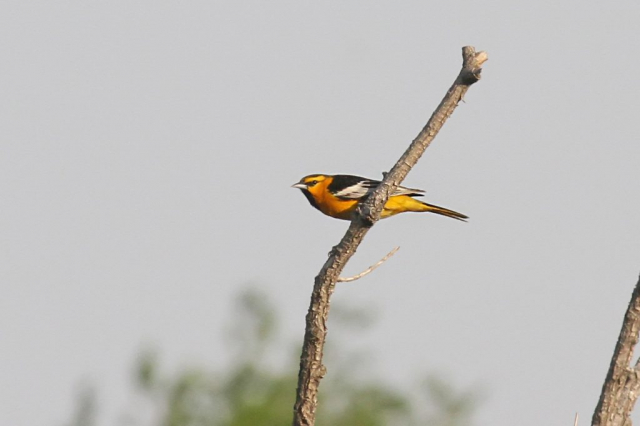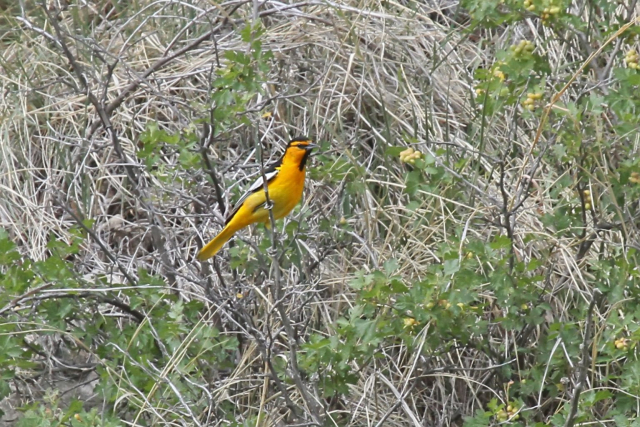Icterus bullockiorum
Status: Fairly common regular spring and fall migrant west and west-central, rare casual elsewhere. Fairly common regular breeder west and extreme southwest.

Documentation: Specimen: UNSM ZM7010, 19 Jun 1901 Indian Creek, Sioux Co.
Taxonomy: No subspecies are recognized (Flood et al 2020, AviList 2025).
It has recently been suggested that because the species was described using material collected by father-and-son naturalists William and William Bullock, the English and Latin names be changed to reflect plurals, as Bullocks’ or by naming rule Bullocks’s (Chesser 2013) and bullockiorum (Chesser 2015). This position was taken by AviList 2025) and is followed here, using the simpler form Bullocks’ as the English name.
For a discussion on hybridization between this species and Baltimore Oriole, see the Bullock’s x Baltimore Oriole (hybrid) species account.
Spring: Apr 30, 30, May 1 <<<>>> summer
Arrival is in early May.
Bullock’s Oriole is found east of the Panhandle during spring migration, but only to a limited extent. Of several reports in the period 30 Apr-29 May, all are since 2003 and most from the North Platte River Valley and southwest: 15 in Keith Co 2-27 May, six in Lincoln Co 5-30 May, and 12 in Dundy, Perkins, and Chase Cos 8-29 May (eBird.org, accessed Jun 2025). Elsewhere, there are only seven documented reports: Hitchcock Co 14 May 2010, Harlan Co 16 May 2019, Smith Falls SP, Cherry Co 19 and 30 May 2024, a singing male in Arthur Co 20 May 2007, and a male photographed in Boyd Co 28 May 2022, and in the east, single adult males in Douglas Co 3 May 2025 and Sarpy Co 9 May 2020. Swenk (Notes Before 1925) reported a specimen in the Olson Collection purportedly taken at Kearney, Buffalo Co Jun 1915, but provided no details.
- High counts: 18 in the Panhandle 28 May 2001, 12 in one bush in Kimball Co 28 May 2011, and 12 near Potter, Cheyenne Co 21 May 2022.
Summer: Short (1961) found pure Bullock’s Orioles eastward only as far as Dawes and Deuel Cos; a nest was found in a ponderosa pine on the Bighorn Escarpment nine miles southwest of Redington in Morrill Co 10 Jun 2000 (Mollhoff 2001). Mollhoff (2016) showed little change in distribution between the first and second breeding bird atlas periods (1984-1989 and 2006-2011); breeding was confirmed throughout the Panhandle, east to Sheridan, Deuel, Chase, and Dundy Cos.
There are nesting season reports without evidence of nesting east to Cherry, Garden, and Keith Cos. In Cherry Co, two were at Merritt Dam 13 Jun 2021, a first-year male and a female were near Valentine 1 and 8 Jun 2024, and one was near Eli 23 Jun 2006. Mollhoff (2016) reported one in extreme southwest Cherry Co. Keith Co reports include a “pure male” at Lake McConaughy, Keith Co 13 Jun 2002, another there 21 Jun 2005, a female photographed near Lake McConaughy 26 Jul 2014 along with three apparent hybrids, and a female in an Ogallala, Keith Co yard during summer 2013. There are no records of phenotypic Bullock’s Orioles nesting in the Keith Co area (Brown et al 2012). Rosche (1994) and Brown et al (1996) found only hybrids and Baltimore Orioles in the Keith Co area, where Bullock’s Oriole was thought to have decreased as a breeding bird in prior years (Brown et al 1996). One was near North Platte, Lincoln Co 19 Jun 2008, a singing male was there 14 Jun 2011, and another adult male 8 Jun 2025. In the southwest, one was in Perkins Co 30 Jun 1972, and in 2011 three were reported: singles in Frontier Co 13 Jun, at Wellfleet, southeast Lincoln Co 1 Jul, and in Chase Co 2 Jul. In 2025, two immature males were at Sutherland Reservoir, Lincoln Co 18 Jun.
Since the 1960s the range may have contracted somewhat as Baltimore Oriole has extended its range westward into northeast Colorado (Andrews and Righter 1992; Corbin and Sibley 1977). Near Crook, Colorado, between the 1950s and 1970s, the percentage of Baltimore Orioles increased while the percentage of intergrades and Bullock’s Orioles decreased (Corbin et al 1979). Bray (1994) made no mention of recent reports of Bullock’s Oriole in the Thomas Co area, although Bullock’s were said to have occurred there some 50 years prior. According to Bates (1900), Bullock’s Oriole was “very common at Long Pine” in Brown Co; he did not list Baltimore Oriole for that area.
BBS trend analysis (Sauer et al 2020) shows a slight annual change of -0.16% (95 C.I. -2.63, 1.94) 1966-2019.
Reports of this species east of the Panhandle are few, and most occurrences probably represent hybrids exhibiting Bullock’s Oriole characters. A nest with eggs was reported at Long Pine, Brown Co 17 Jul 1898; it is #29 at Sellors-Barton Museum, Ainsworth, Nebraska (Mollhoff 2022). It seems likely that this Brown Co nest was either by hybrid parents or the parents misidentified; Brogie and Mossman (1983) found only hybrids and Baltimore Orioles in the Niobrara Valley Preserve. An interesting nesting was monitored in Jun-Jul near Valentine, Cherry Co; both parents appeared to be hybrids, but the female of the pair disappeared, leaving the male to successfully fledge the two chicks 9 Jul (Gordon Warrick, personal communication). An easterly hybrid in southwest Custer Co 5 Jun that “came in very nicely to a Bullock’s Oriole song played on my phone – was a lighter orange than most male Baltimores but had full black hood” (T. J. Walker, personal communication).
- Breeding phenology:
Nest building: 25 May-1 Jul
Eggs: 10 Jun-17 Jul (Mollhoff 2022)
Nestlings: 3 Jun-12 Jul
Fledglings: 7-22 Jul
Fall: summer <<<>>> Sep 11 (Rosche 1994), 11, 12 (Rosche 1982)
Later dates are 18 Sep 2010 adult male near Mitchell, Scotts Bluff Co, and 25 Sep 2008 immature photographed near Mitchell, Scotts Bluff Co.
Departure begins in Jul, and is completed in early Sep. There are two easterly fall reports from Lincoln Co, 9 Aug 2011 and 11 Sep 2008, and two were in Perkins Co 16 Jul 2023.
This species undergoes a molt migration in fall (Pillar et al 2016), with adults usually departing early; the last male at a Mitchell feeder in 2008 was seen 13 Jul and on the same date in 2018. At this same feeding station near Mitchell in 2009, four families with young were in attendance. The males were absent and apparently departed when the juveniles were able to feed themselves; the females and juveniles apparently departed together a month later, around mid-Aug (Kathy DeLara, personal communication). In 2010 at the same feeder, only females and an immature were present 31 Jul, and in 2012 a young male (possibly a hybrid) was last seen 1 Sep. “All age groups” had abandoned an active Scotts Bluff Co feeder by 4 Aug in 2023 (Marie Smith, personal communication).
There are five reports of Bullock’s Oriole in the eastern half of the state. A group of five, including an adult male Bullock’s and four immature or female birds, possibly hybrids, was at Alma, Harlan Co 11 Aug 1999, a female was at Lake North, Platte Co 21 Aug 2006, an adult male was carefully studied at Fontenelle Forest, Sarpy Co 4 Sep 2004, and a first fall male was photographed in Lancaster Co 11 Sep 2020.
- High counts: 6 at Lake Ogallala, Keith Co 12 Aug 2024.
Images
Abbreviations
BBS: Breeding Bird Survey
UNSM: University of Nebraska State Museum
Literature Cited
Andrews, R., and R. Righter. 1992. Colorado birds. Denver Museum of Natural History, Denver, Colorado, USA.
AviList Core Team, 2025. AviList: The Global Avian Checklist, v2025. https://doi.org/10.2173/avilist.v2025.
Bates, J.M. 1900. Additional notes and observations on the birds of northern Nebraska. Proceedings of Nebraska Ornithologists’ Union 1: 15-18.
Bray, T.E. 1994. Habitat utilization by birds in a man-made forest in the Nebraska Sandhills. M.S. thesis, University of Nebraska-Omaha.
Brogie, M.A., and M.J. Mossman. 1983. Spring and summer birds of the Niobrara Valley Preserve, Nebraska: An annotated checklist. NBR 51: 44-51.
Brown, C.R., M.B. Brown, P.A. Johnsgard, J. Kren, and W.C. Scharf. 1996. Birds of the Cedar Point Biological Station area, Keith and Garden Counties, Nebraska: Seasonal occurrence and breeding data. Transactions of the Nebraska Academy of Sciences 23: 91-108.
Brown, M.B., S.J. Dinsmore, and C.R. Brown. 2012. Birds of Southwestern Nebraska. Conservation and Survey Division, Institute of Agriculture and Natural Resources, University of Nebraska—Lincoln, Lincoln, Nebraska, USA.
Chesser, R.T. 2013. On the correct name of Icterus bullockii (Passeriformes: Icteridae). Zootaxa 3718.
Chesser, R.T. 2015. A further note on the scientific name of Bullocks’ Oriole. Zootaxa 3956: 444.
Corbin, K. W. and C. G. Sibley. 1977. Rapid evolution in orioles of the genus Icterus. Condor 79: 335-342.
Corbin, K.W., C.G. Sibley, and A. Ferguson. 1979. Genetic changes associated with the establishment of sympatry in orioles of the genus Icterus. Evolution 33: 624-633.
Flood, N.J., C.L. Schlueter, M.W. Reudink, P. Pyle, M.A. Patten, J.D. Rising, and P.L. Williams. 2020. Bullock’s Oriole (Icterus bullockii), version 1.0. In Birds of the World (P. G. Rodewald, Editor). Cornell Lab of Ornithology, Ithaca, NY, USA. https://doi.org/10.2173/bow.bulori.01.
Mollhoff, W.J. 2001. 1999-2000 Nebraska nesting report. NBR 69: 92-101.
Mollhoff, W.J. 2016. The Second Nebraska Breeding Bird Atlas. Bull. Univ. Nebraska State Museum Vol 29. University of Nebraska State Museum, Lincoln, Nebraska, USA.
Mollhoff, W.J. 2022. Nest records of Nebraska birds. Nebraska Ornithologists’ Union Occasional Paper Number 9.
Pillar, A G., P.P. Marra, N.J. Flood, and M.W. Reudink. 2016. Moult migration in Bullock’s Orioles (Icterus bullockii) confirmed by geolocators and stable isotope analysis. Journal of Ornithology 157: 265-275.
Rosche, R.C. 1982. Birds of northwestern Nebraska and southwestern South Dakota, an annotated checklist. Cottonwood Press, Crawford, Nebraska, USA.
Rosche, R.C. 1994. Birds of the Lake McConaughy area and the North Platte River valley, Nebraska. Published by the author, Chadron, Nebraska, USA.
Sauer, J.R., W.A. Link and J.E. Hines. 2020. The North American Breeding Bird Survey – Analysis Results 1966-2019. U.S. Geological Survey data release, https://doi.org/10.5066/P96A7675, accessed 27 Jul 2023.
Short, L.L., Jr. 1961. Notes on bird distribution in the central Plains. NBR 29: 2-22.
Swenk, M.H. Notes before 1925. Bird notes from A.M. Brooking of Hastings, C.A. Black of Kearney, and B.J. Olson of Kearney, based chiefly on their collections, up to January 1, 1925. Typed manuscript in the Nebraska Ornithologists’ Union Archives, University of Nebraska State Museum, Lincoln, Nebraska, USA.
Recommended Citation
Silcock, W.R., and J.G. Jorgensen. 2025. Bullock’s Oriole (Icterus bullockii). In Birds of Nebraska — Online. www.BirdsofNebraska.org
Birds of Nebraska – Online
Updated 2 Sep 2025


